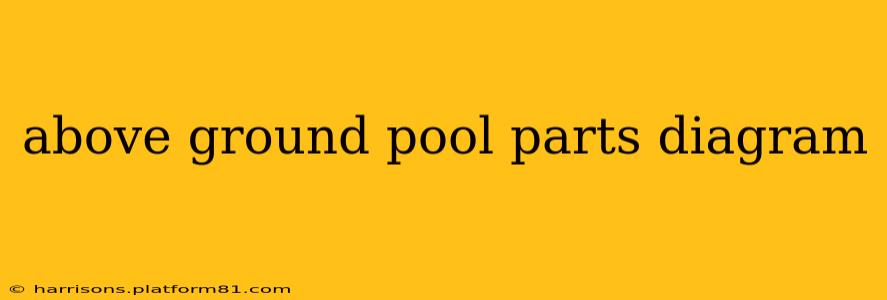Planning to install or maintain your above-ground pool? Understanding the various components and their functions is crucial for a successful and enjoyable swimming experience. This comprehensive guide provides a detailed breakdown of above-ground pool parts, complete with diagrams and explanations to help you navigate the world of pool ownership with confidence.
We'll cover everything from the basic structural elements to the essential accessories, ensuring you have a clear understanding of each part's role in keeping your pool clean, safe, and sparkling. Let's dive in!
What are the Main Parts of an Above Ground Pool?
A typical above-ground pool comprises several key components, working together to create a refreshing oasis in your backyard. These include:
- Pool Walls: These are usually made of steel, resin, or aluminum, providing the structural integrity of the pool. The material choice impacts durability, aesthetics, and price.
- Pool Liner: This is the waterproof membrane that lines the inside of the pool walls. It's typically made of vinyl and comes in various colors and patterns. The liner is crucial for water retention and aesthetic appeal.
- Pool Bottom: This is the base of the pool, often made of a durable vinyl or similar material, depending on the type of pool and liner. It provides a smooth, watertight surface.
- Pool Frame: This supports the pool walls and provides overall structural support. The strength and design of the frame significantly impact the pool's stability and longevity. Different materials, such as steel, are used for various pool sizes and designs.
- Support Posts/Up Rights: These are vertical supports that add extra stability to the frame, particularly important for larger pools. Their placement depends on the pool's size and design.
What are the Different Types of Above Ground Pool Frames?
Choosing the right frame is crucial for pool stability and longevity. Common frame types include:
- Steel Frames: These are the most common and generally offer good strength and affordability. They can be galvanized or powder-coated for rust resistance.
- Aluminum Frames: While more expensive than steel, aluminum frames are lighter, rust-resistant, and often require less maintenance.
- Resin Frames: These offer a sleek, modern look and are very resistant to corrosion. They tend to be more expensive but also highly durable.
How Do I Identify Parts on My Above Ground Pool?
Identifying specific parts can be challenging without a diagram specific to your pool model. Consult your pool's installation manual for a detailed diagram and parts list. If you've lost your manual, many manufacturers have online resources with diagrams and part lists, searchable by model number, often found on their website's support section.
What Accessories are Commonly Used with Above Ground Pools?
Beyond the basic structural components, several accessories enhance the pool experience:
- Filter System: This is crucial for maintaining water clarity and cleanliness. Different filter types (sand, cartridge, etc.) offer varying levels of filtration.
- Pump: This circulates water through the filter system, removing debris and maintaining water chemistry.
- Skimmer: This surface-cleaning device removes debris floating on the water's surface.
- Return Jets: These distribute filtered water back into the pool, creating circulation and evenly distributing chemicals.
- Ladder: A safe and sturdy ladder provides access to and from the pool.
- Handrail: This adds safety and stability, particularly helpful for entry and exit.
- Pool Cover: Protects the pool from debris and evaporation when not in use.
- Cleaning Accessories: Nets, brushes, and vacuum systems are needed for regular pool maintenance.
What are the common problems with above ground pool parts?
Common issues include:
- Rusting (Steel Frames): Regular maintenance, including cleaning and occasional repainting, helps prevent rust.
- Liner Tears: Gentle handling and proper winterization help prevent tears.
- Pump/Filter Issues: Regular cleaning and maintenance extend the life of these components.
- Clogged Pipes and Filters: Regular backwashing (for sand filters) and cleaning (for cartridge filters) are crucial.
Understanding the various parts of your above-ground pool is key to proper maintenance and a long lifespan. Regularly inspecting your pool and addressing any issues promptly will ensure years of swimming enjoyment. Remember to always consult your owner's manual for specific instructions and maintenance recommendations for your particular model.
